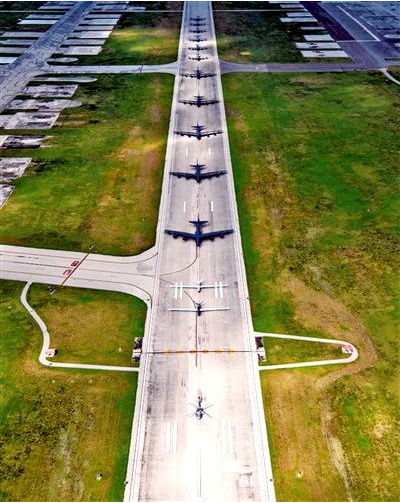
By Chen Lufan
American media reported that all the five B-52H Stratofortress bombers of the US military departed from the Andersen Air Force Base (AFB) in Guam on April 16 for their home base at Minot AFB in North Dakota, with no aircraft arriving to replace them. This put an end to the US Air Force’s continuous bomber presence in the Pacific region since 2004.
What’s intriguing was that these bombers just participated in the massive “elephant walk” show of force several days ago, which was interpreted as an important signal that the US is now targeting other major countries.
The USAF’s abrupt withdrawal of all B-52H bombers from Andersen AFB captured extensive attention. Some analysts said the withdrawal might be required by America’s prevention and control of the COVID-19 pandemic on its homeland.
After the aircraft carrier USS Theodore Roosevelt arrived on March 27 with hundreds of sailors infected with COVID-19, most of the service members got off and were quarantined, putting a lot of strain on the local health care system and hindering the pandemic containment on the island. The return of B-52H bombers, which have come to the end of their mission, will lessen the logistics pressure and reveals the US military’s eagerness given the extended military travel ban. It’s also within reason that the US didn’t assign new aircraft in order to reduce the flow of personnel and avoid massive deployments.
However, this move may not be an innocent expedient as far as the US overall strategic layout is concerned, but an important signal of accelerated adjustment of its military strategy driven by the novel coronavirus outbreak. It is anticipated to exert significant impacts on the US military’s strategic deployments worldwide.
In recent years, certain countries labeled by the US as main strategic competitors have acquired medium- and long-range strike capability, making fixed military bases more vulnerable. Therefore, the Pentagon has been mulling ways to change the traditional mode of deployment and enhance maritime maneuverability while intensifying its deployments in the Indo-Pacific region.
In the meantime, the US military has increasingly adopted a combat concept called “Dynamic Force Employment”, which is aimed at making major military deployments less predictable to unsettle potential rivals.
Earlier in April, the US Navy expressed its intention of curtailing the stationing of bombers in Guam. The USAF Major Kate Atanasoff, a US Strategic Command (STRATCOM) spokesperson, confirmed the bomber withdrawal in a recent statement. "In line with the National Defense Strategy, the United States has transitioned to an approach that enables strategic bombers to operate forward in the Indo-Pacific region from a broader array of overseas locations, when required, and with greater operational resilience, while these bombers are permanently based in the United States. US strategic bombers will continue to operate in the Indo-Pacific, including Guam, at the America’s timing and tempo."
While the COVID-19 pandemic has caused numerous infections and deaths in the US, the military re-deployment is obviously not intended to weaken the US military deterrence in the region, but to enhance it. The new move will exert far-reaching impacts on the Indo-Pacific region, on America’s global deployments, and on the world military landscape.
According to experts, American bombers are likely to pose more diverse threats to Asian countries in the future. It was easy to monitor the bombers in Guam in the past because their deployment was relatively fixed. Now with the adoption of the “Dynamic Force Employment”, US bombers may approach East Asia in new ways with the help of tanker airplane, which makes them hard to defend against as there is less visible deterrence but more invisible threats. As a result, it is necessary for relevant countries to establish an air early warning system with more comprehensive coverage and longer detection range.













